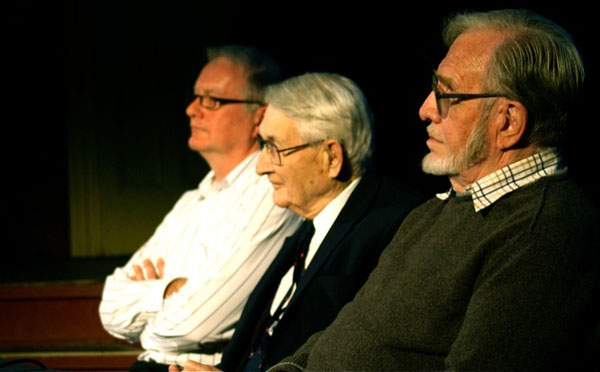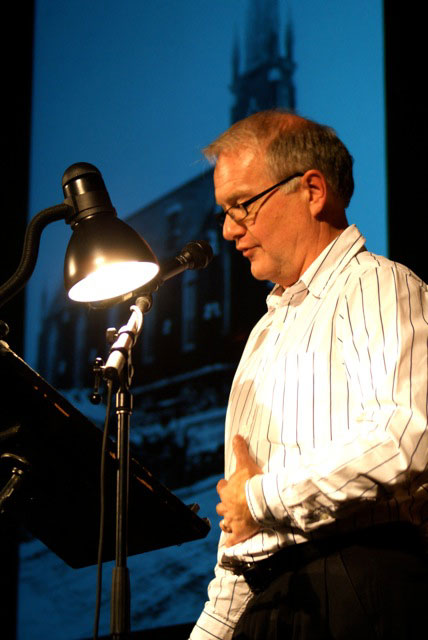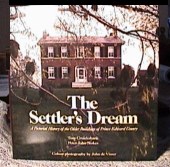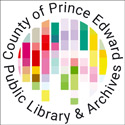Prince Edward County has been living The Settlers Dream and destroying it
Administrator | Nov 05, 2010 | Comments 1

Tom Cruickshank, Peter John Stokes and John de Visser answer questions about heritage advisory committees. Theresa Durning photo www.in-the-bag.ca
By Theresa Durning
It seems the County revels in history and heritage – just not enough. With a visual backdrop of the recently demolished Methodist Church, Tom Cruickshank co-author of The Settlers’ Dream, focused on the hits and misses the community has experienced since publication of the Dream. Although critically acclaimed, The Settlers’ Dream was never a best seller but, after close to five years of cataloguing, photographing, research and writing, and 26 years since its publication, The Dream is still alive and an important insight into the architectural heritage of Prince Edward County.

With a visual backdrop of the recently demolished Methodist Church, Tom Cruickshank co-author of The Settlers' Dream, focused on the hits and misses the community has experienced since publication of The Settlers Dream. Theresa Durning photo. www.in-the-bag.ca
Cruickshank lectured passionately to his audience at The Regent Theatre last night, of the architectural hits since the publication hit the book stores -including The Claramont – and the misses, the Rickarton Castle and the Castle Villeneuve. Bank buildings did not escape the critical eye of Cruickshank who noted that PEC was in good company with most of Ontario on this issue. It seems Canadian banks have a long history of demolishing buildings on Main Streets and implanting the “misses” that barely pass for architecture.
Along with photographer John de Visser and architect, Peter John Stokes, Cruickshank catalogued well over five thousand structures in The County. “Much of my time was spent driving around, knocking on doors to ask permission to photograph and research. That part of the work didn’t take as long as the being invited in to hear the stories of generations of families who had been living on the same properties and sorting through thousands of photographs taken over the years.”
Following his lecture, Cruickshank was joined by de Visser and Stokes to answer questions the audience had about Heritage Advisory Committees, LACAC’s, retrofits and refurbishing. The audience was urged to create its own Local Architectural Conservancy Advisory Committee and warned, while most Heritage Advisory Committees do some great work in communities they are tied to municipal councils. LACAC’s are independent groups of concerned individuals.
The evening’s moderator, Peter Lockyer of Heritage Moments and owner of History Lives Here, has created a wish list of ideas to help the community move forward on “The Dream” creation of a LACAC or umbrella organization of heritage and history.
The Dream
1. We need to devise an organizational structure that takes ownership and provides leadership on this file while there is interest and momentum. I am loathe to form yet another group when there are already so many. But we do need an umbrella organization under which we all operate. Could be a local chapter of the Architectural Conservancy of Ontario (existing group, lots of experience and very credible) or a current group in the County, or we form a new one that is Heritage Prince Edward
2. What is really, really important is that we all operate under one house. We currently compete for volunteers and limited funding. We compete with our events. We don’t speak with one voice. And we are all having limited impact because we are operating in this fragmented manner. We simply won’t survive operating as small, fragmented groups.
3. We need a clear strategy that engages the community – schools are involved because we are working with them to design curriculum resources; other groups like the Picton Fair are serving as a focal point of our efforts because they have adopted an “1880s period fair approach”; all media are engaged in promoting history and heritage by using the History Moments or other products; we engage our artists and business people in developing and retailing heritage – related products (heritage wines, educational toys,heritage calendars, History Moments, lectures, plays, walking and bus tours, whatever)
4. Finally, I firmly believe we need to approach this as a business and not another grants-driven, artsy – fartsy sort of thing. There is a marketplace demand for professionally produced goods and services extensively marketed at every retailer in the County. Retailers make money off of everything they sell for us to encourage them to flog the stuff. Schools could sell the stuff to raise money for their projects while raising money for us. This money then is pooled into our “for-profit” business.
We use it to:
– employ local people to produce professional products for us
-to fund moneymaking heritage events (The period Fair, Heritage Trail, etc.)
– to extensively market our products and enhance education about history and heritage (workshops and conferences as an example on heritage themes, into schools, online distribution, media promotion)
– to create small grant and recognition programs to encourage restoration projects
– to create an inventory of best heritage practices and policy so we are a leading edge community
– to develop an inventory of skilled restoration trades people in our community and to encourage apprenticeships that create jobs for young people
– to invest in heritage projects like the restoration of the Royal Hotel or the conversion of the Downes House by its owner into a County wines retail shop. We become investors in business opportunities that preserve heritage buildings or special places like the Al Purdy House.
It may be we can interest grant funders in a pilot project that “kick starts” this initiative. But we need to get out of the grant industry as fast as we can; and we need to get out of the small bottle drives and over-priced chicken dinners with a silent auction that are the current cornerstones of our fundraising efforts. I am developing a draft document on this which I will circulate next week.
-Theresa Durning www.in-the-bag.ca
* * *
 The County’s Heritage at a Crossroads
The County’s Heritage at a Crossroads
Re-claiming Prince Edward County’s disappearing history and heritage will be the topic of a lecture by Tom Cruickshank, co-author of The Settler’s Dream, the definitive book on the Loyalist settlement of Prince Edward County.
The lecture will take place at 7 pm. at Picton’s Regent Theatre on Thursday, Nov. 4, sponsored by the Glenwood Cemetery Company and made possible through a grant from the Ontario Trillium Foundation.
Tom Cruickshank has a longstanding interest in heritage architecture through his research work with restoration architect Peter Stokes. The two worked closely along with nationally – renowned photographer John de Visser on the book, The Settler’s Dream, first published in 1984. The commemorative volume was re-printed in 2009 as part of the celebration of the 225th anniversary of the Loyalist settlement of Prince Edward County. Five thousand County buildings were photographed and catalogued as part of this extensive research project.
Since then Mr. Cruickshank has collaborated on three other books on heritage architecture and preservation. His most recent work, Old Toronto Houses, published in 2004 won the Award of Excellence from Heritage Toronto. By day, Tom is the editor of Harrowsmith Country Life Magazine. He lives with his wife, Darlene, on an old homestead between Port Hope and Peterborough.
The co-author of The Settler’s Dream, architect Peter Stokes, and photographer John de Visser, will also be available for a Question and Answer period following the lecture and a book signing of their work.
Tickets can be purchased at The Regent Theatre box office 224 Main Street in Picton. telephone: 613 476 8416 e-mail: info@TheRegentTheatre.org
Filed Under: Featured Articles
About the Author:
































Great idea to create Prince Edward County LACAC’s and not rely on something that is connected to council. We need an outside group such as Peter suggested like Heritage Prince Edward